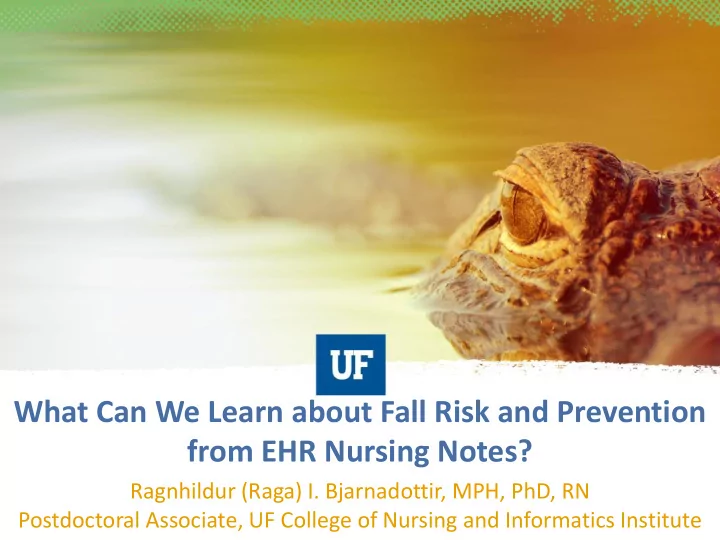

What Can We Learn about Fall Risk and Prevention from EHR Nursing Notes? Ragnhildur (Raga) I. Bjarnadottir, MPH, PhD, RN Postdoctoral Associate, UF College of Nursing and Informatics Institute
Outline: • Significance • Theoretical framework • Methods • Results • Discussion • Implications
Significance
The problem of hospital falls ~ 1% result in death ~ 10% result in severe injury ~ 30-50% result in injury ~ 1 million patient falls annually
The Cost of Falls Predicted to reach $34 billion in direct Top 20 most expensive $54.9 medical cost annually medical conditions billion by 2020 ~$30,000 per fall
Evidence Gap • Fall risk assessment tools have limited predictive value • Lack of validation of fall risk prediction models • Despite falls being considered a nurse-sensitive outcome, few studies have examined registered nurses’ (RNs’) narrative notes as a source of actionable data
Purpose To explore whether there is meaningful fall risk and prevention information in RNs’ electronic narrative notes not found in structured electronic health record (EHR) data.
Theoretical Frameworks
Donabedian’s Quality Framework Structure Outcome Process
Choi’s Multi-Systemic Fall Prevention Model Characteristics Risk Factors of Outcomes Interventions Environment- Extrinsic Risk Factors Related Environmental Risk Factors Interventions Intrinsic Risk Factors Care Process & A Reduction in Falls Patient-Related Culture-Related and Fall Related Physiological and Interventions Injuries Psychological Factors Technology-Related Interventions
Methods
Text mining: • “The process or practice of examining large collections of written resources in order to generate new information” • A subset of data mining that focuses on unstructured data • Natural Language Processing is “a component of text mining that performs a special kind of linguistic analysis that essentially helps a machine “read” text”
Overview of process Pre- Trans- Inter- Data Selection Processing formation pretation Mining Preprocessed Target Data Transformed Patterns Knowledge Data Data Data
• Medical Information Mart for Intensive Care (MIMIC-III) database • Deidentified EHR data associated with patients who stayed in critical care units between 2001 and 2012 Characteristics of full MIMIC III Sample (N=38,597) Age 65.8 (52.8-77.8) Male gender 27,983 (55.9%) Length of stay (median) 6.9 days (4.1-11.9) Hospital mortality 5,748 (11.5%)
• Supervised text mining using a lexicon developed based on : • Review of literature, guidelines and terminologies • Qualitative interviews with hospital nurses (Fehlberg et al, under review) • Clinical and domain experts Literature Fall SNOMED- Prevention CT Toolkits Lexicon Develop- ment Clinical ICD-9 Experts NANDA
Results
Total l sam sample: 1,0 1,046,053 not otes fr from 36 36,5 ,583 pati tients Characteristics of Outcomes Risk Factors Interventions Extrinsic Risk Factors Environmental Risk Factors Environment-Related Interventions 718 notes (0.07% of all notes) 2440 notes (0.23% of all 406 patients (1.1% of all notes) patients) 1060 patients (2.9% of all patients) Intrinsic Risk Factors A Reduction in Care Process & Culture- Patient-Related Physiological Related Interventions and Psychological Factors Falls and Fall 103,685 notes (9.9% of all 130 notes (0.01% of all Related Injuries notes) notes) 23,025 patients (62.9% of 99 patients (0.27% of all all patients) patients) Explicit mentions of fall Technology-Related risk or events Interventions 414 notes (0.04% of all 4,138 notes (0.4% of all notes) notes) 220 patients (0.60% of all 1758 patients (4.8% of all patients) patients)
Extrinsic Risk Factors: Physical Environment • Fall circumstances • “Fell on “a slippery floor” unwitnessed” • Hazardous conditions • “Found walking around the room using unstable furniture to aid him” • Fall prevention activities • “Kept bed low and locked; adequate lighting, items within reach”
Extrinsic Risk Factors: Staffing and Organizational Factors • Understaffing • “Transfer held until after 7p due to staffing issues on receiving unit” • “Hospital ICU charge RN called during the night and advised that they have a nursing staffing shortage for today” • Adequate or additional staffing • “Pt receiving 1:1 observation, RN staffing” • Staffing through the care trajectory • “The VNA would also need to know exact d'c date in order to have available staffing”
Discussion • Nurses narrative notes contain information about factors that could impact fall risk • Includes information not captured in routine structured data, such as organizational and environmental factors • Further research is needed to determine the predictive value of these factors.
Limitations • Dataset: • Single hospital • Critical care data only • Unlabeled data (i.e. unable to distinguish between fallers and non-fallers) • Methods • Supervised approach limits findings to what is included in lexicon
Implications • Findings highlight a potentially rich but understudied source of actionable clinical and organizational data • Application of novel methods to identify quality and safety measures in RNs’ notes can uncover meaningful observations and clinical judgement for patient outcomes and health services research • Future research should: • Take into account clinical and contextual features (i.e., prevalence) • Evaluate the predictive value of nursing assessment data found in progress notes
Acknowledgements: Dr. Robert Lucero, co-author and Postdoctoral Mentor Generously funded by UF College of Nursing and UF Informatics Institute Thank You! Questions? Contact: Ragnhildur I. Bjarnadottir rib@ufl.edu Tel: 352-263-6508 1225 Center Drive, Suite 3214
Additional slides
Fall-related ICD-9 codes Code Description Notes External causes E884 Other fall from one level to another 0 of accident E885 Fall on same level from slipping, tripping or stumbling 0 E887 Fracture, cause unspecified 34 E888 Other and unspecified fall 20 800-829 Fractures 1 HAC Fall Codes (CMS) 830-839 Dislocation 1 850-854 Intracranial injury 0 925-929 Crushing injury 0 940-949 Burn 15 991-994 Electric Shock 2 Total: 73
• Stop word removal: • Removal of common words that don’t have meaning for analysis (e.g. the, that, at, on) • Stemming: • Reduction of inflected words to their root (e.g. from falling to fall)
• A sequence of a certain number of words or characters from a larger string • Unigram = one word sequence (fall) • Bigram = two word sequence (patient fall) • Trigram = three word sequence (fall related injury)
Recommend
More recommend